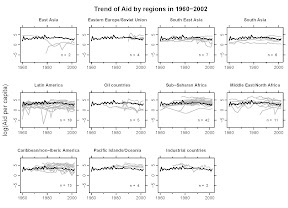In fact, I have a whole page in the paper, arguing why (Bayesian) multilevel modeling (BML) is better than other alternatives (OLS with PCSE's, FE, RE, etc). The paper by Shor et al (2007) in Political Analysis has shown the superiority of BML with the Monte Carlo experiments.
Besides theoretically arguments, I have a Figure (see below) where I plot aid trends by regions across countries from 1960--2002. The light lines indicate individual country aid trend and the dark lines represent the world average aid trend. The plot clearly shows that there are variation across regions, between countries and by years. So in the paper, I propose to use BML to model the aid allocation.
 |
Today, I asked Andy's about his views on this issue. I got most out of his answers was his first quick and simple response: ``OLS is a special case of multilevel modeling where the group level variation is zero." For me, this is a straight forward way of looking at the issue of why BML not OLS. ``Multilevel modeling is an easier thing to do!" Although I don't know if others would believe this, but it is the case when you think about doing all kind of data transformations, creating dummies to correct the potential problem in the Time-Series Cross-sectional data.
Assuming my discussant read my paper carefully, she must have got the idea of why I used BML from the discussion in the page and the figure. So I am thinking maybe what she wanted was a hard evidence, showing that the BML's result is better. And this is in fact very common, at least for paper published in polisci journal, that authors always have a base model (OLS) in a table where all other advanced model are presented on the right of the OLS one.
I guess what I tries to convey in this entry is: if you believe your model is better (or correct), why bother going back to a simple model? Even if the results may be similar, we still get something out of the advanced modeling as we're definitely taking care of more aspects of the data. Maybe the norm of the discipline made us to do all this redundant procedure. But advanced modeling certainly does not necessarily mean more difficult to do.




No comments:
Post a Comment